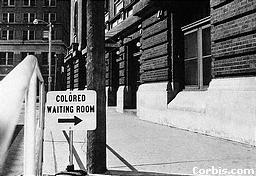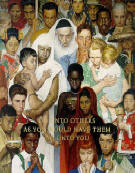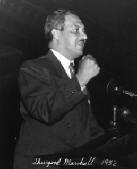 |
|
Brown vs. Topeka
Board of Education
|
|
• About Us • Contact Us • Search •
|
|

Segregation
|
For more than 200 years before the
Civil War, slavery existed in the United States. But after
the war things began to get worse for blacks. The south
thought they needed to do something. The Southern
legislatures, former confederates, passed laws known as the
black codes, after the war, which severely limited the
rights of blacks and segregated them from whites.

Now before there was no need to
separate whites and blacks because 95% of blacks were
slaves. But they were separated at schools, theaters,
taverns, and other public places. So, Congress quickly
responded to these laws in 1866 and seized the initiative in
remaking the south. Republicans wanted to ensure that with
the remaking the south, freed blacks were made viable
members of society. But the strong southern legislatures
finally gave in; in 1868 they repealed most of the laws that
discriminated against blacks.
Things were starting to look up. But
by 1877 Democratic parties regained their power of the south
and ended reconstruction. This was devastating to the
blacks. After all the strides they made were reversed.
From holding political offices, the right to vote, and
participating as equal members of society was changed.
|
|
The south
gradually reinstated the racially discriminatory laws. The
two main goals they wanted these laws to achieve:
disenfranchisement and segregation. To take away the power
that the blacks had gained, the Democratic Party began to
stop Blacks from voting. |
|
There were many ways to stop
blacks from voting. Some of these things were poll taxes,
fees were charged at voting booths and were expensive for
most blacks, and the literacy test. Since teaching blacks
were illegal, most adult blacks were former slaves and
illiterate. And the other goal, segregation, causes the
democrats to create laws that segregated the schools and
public facilities.
|
|
In addition, the civil rights
case of 1883 the Supreme Court declared that congress had no
power to prevent private acts of discrimination.
“When a man
has emerged from slavery, and by the aid of beneficent
legislation …. There must be some stage in the process of
his elevation when takes the rank of a mere citizen or, a
man, ceases to be the special favorite of the laws, and
when his rights as a citizen, or a man, are to be
protected in the ordinary models by which other men’s
rights are protected.”
- Justice Joseph Bradley
And with
that ruling and other cases like Plessy vs. Ferguson and
Williams vs. Mississippi they could stop blacks from voting
and segregation could be done. For example in1896 as
much as130, 344 blacks were registered to vote in Louisiana;
but in the 1900’s the new Louisiana Constitution reduced
that to 5,320. And in Alabama 3,000 out of 180,000
were registered to vote at the voting age in the 1900’s.
The blacks were becoming the “special targets” of the
law.
|
|
By the
1900’s the southern legislators carried segregation to the
extremes. Here are some of the years and states where it
started:
 |
1914: Louisiana required separate entrances
for blacks and whites. |
 |
1915: Oklahoma segregated telephone booths. |
 |
1920: Mississippi made it a crime to
advocate or publish “arguments or suggestions in favor of
social equalities or of interracial between whites and
Negro’s”. |
 |
Arkansas had segregation at racetracks. |
 |
Texas prohibited integrated boxing matches. |
 |
Kentucky required separate schools, and
also that no textbook would be issued to a black would
ever be reissued or redistributed, they also prohibited
interracial marriage. |
 |
Georgia bared black ministers from
performing a marriage between white couples. |
 |
New Orleans created segregated red light
districts for white and blacks prostitutes. |
When the
U.S. entered WW II the south was a fully segregated
society. Everything from schools, restaurants, hotels,
train cars, waiting rooms, elevators, public bathrooms,
colleges, hospitals, cemetery, swimming pools, drinking
fountains, prisons, and even churches were for whites or
blacks but never for both.
|
|
 |
 |
 |
 |
 |
Viewer Advice |
 |
 |
 |
 |
 |
Best Viewed in:
800x600 Resolution
with

Microsoft Internet Explorer
Created with:

Front Page |
 |
|
|

Violence
|
|
|
|
Segregation was supported by the legal system and
police. But beyond the law there
was always a threat by terrorist violence. The Ku Klux Klan, Knights of White Camellia, and other terrorists
murdered thousands of blacks and some whites to prevent them from voting and
participating in public life.
The KKK was
founded in 1865 to 1866. They
directed their violence towards black landowners, politicians, and community
leaders. They also did this to people who supported Republicans or
racial equalities.
|
| |
|
Segregation was supported by the legal system and
police. But beyond the law there
was always a threat by terrorist violence. The Ku Klux Klan, Knights of White Camellia, and other terrorists
murdered thousands of blacks and some whites to prevent them from voting and
participating in public life.
The KKK was
founded in 1865 to 1866. They
directed their violence towards black landowners, politicians, and community
leaders. They also did this to people who supported Republicans or
racial equalities.
|
|
|
One of the main
forms of violence was lynching. Between
1884 and the 1900 white mobs lynched more than 2,000 blacks in the South. They
were also lynched for any violation of the southern code. They also burned them alive, shot them, or beat them to
death. |
|
|

Jim
Crow Laws
|
|
The Jim Crow
was a system of laws and customs that enforced racial segregation and
discrimination throughout the United States, especially in the South, from the
late 19th century through the 1960’s. The laws did not specifically mention race, but were written and applied
in a way that discriminated against African Americans.
The tradition
of Jim Crow began in February 1843, when a group of four white men from
Virginia, billed as the “Virginia Minstrel”, applied black cork to their
faces and performed a song-and-dance act in a small hall in New York City.
The performance was such a success that the group was invited to tour to
other cities and imitators sprang up immediately. These troops were successors
to individual performers who imitated Negro singing and dancing.
|
|
|
But it was not
until after Radical Reconstruction ended in 1877 that the Jim Crow was born.
Jim Crow grew slowly. In the
last two decades of the nineteenth century, many African Americans still enjoyed
the rights granted in the 13th, 14th, and 15th
Amendments, along with the 1875 Civil Rights Act. Blacks and Whites rode together in the same railway cars, ate
in the same restaurants, used the same public facilities, but did not interact
as equals. That was about to change
altogether.
In the case of
Plessy v. Ferguson (1896), the court held that the Civil Rights Act of 1875 was
unconstitutional and ruled that the 14th Amendment did not prohibit
individuals and private organizations from discriminating on the basis of race,
hence the southern slogan “separate but equal”. This ruling was the start of legalized racial segregation.
Laws were enacted that restricted all aspects of life and varied from
state to state. Some states said
that such laws were written to “protect” both races.
|
|
|
Crow extended
to deny private as well as public, or civil, rights to all African Americans.
They were denied all social forms of respect. Whites addressed even black adults as “boy”, and all blacks were
expected to show difference to all whites. Signs reading “Whites Only” or “Colored” hung over drinking
fountains and doors to almost every public place.
By 1914 every
Southern state had passed laws that created two separate societies: one black,
the other white. The combination of constant humiliation, dismal economic
opportunities, and segregated education for their children made thousands of
African Americans leave the South in the Jim Crow era. Blacks and whites could not ride together in the same railroad cars, sit
in the same restaurants, or sit in the same theaters. Blacks were denied access to parks, beaches, picnic areas, and from many
hospitals.
|
|
|
There was
segregation in hotels, stores, entertainment, and libraries. All this fueling an atmosphere of racism and a rise in lynching, rioting,
and the Ku Klux Klan.
Blacks,
particularly in the South, faced discrimination in jobs and housing, and were
often denied their constitutional right to vote through literacy tests and poll
taxes administered with informal loopholes and trick questions. Some states had curfews for African Americans, and sometimes they were
restricted from even working in the same room as whites.
|
|
|
Different court
cases, particularly in the 1940’s cases, Sweat v. Paiter and McLaurin v.
Oklahoma, broke down the “separate but equal” standard. Then finally outlawed state-sponsored segregation in 1954’s Brown v.
Topeka Board of Education ruling.
This ruling led
to an assortment of legal suits, mass sit-ins, and boycotts to hasten
desegregation, mostly contributed by members of the NAACP (National Association
of the Advancement of Colored People)
|
|
|
But despite
victories against segregation and discrimination, African Americans continued to
face unequal opportunities, and new approaches, such as the Civil Rights Act of
1964, the Voting Rights Act of 1965, the Fair Housing Act of 1968, and the Black
Power Movement, was the definite ending to the Jim Crow Laws.
|
|

Civil
Rights Movement
|
|
|
|
Segregation was
made difficult because of violence and the power of state governments. Blacks tried to fight segregation in many ways like at the ballot boxes,
in the courtrooms, and through organizations like the National Association of
the Advancement of Colored People. Which
was founded in 1909. After the
Civil Rights Act of 1883, blacks held meetings. Frederick Douglas gave speeches at large protest; he made groups like
Brotherhood of Liberty to plan legal and political action against segregation.
|
|
|
People of black
color, groups of mixed African American, and European ancestry joined together
to fight segregation of trains in New Orleans. In 1905 a number of Black
activists, led by W.E.B. Dubois, the first African American to receive a
doctorial degree from Harvard University, met in Niagara Falls, Ontario, Canada
to plan strategies to fight racial equality. By 1909 they were called the Niagara Movement, which led to the NAACP.
The National Association of the Advancement of Colored People began to
challenge segregation in court. Before
World War 2, there were some significant victories. Guinn v. the United States (1915), Buchanan v. Warley (1917),
and Gaines v. Canada (1937) were only a few. During the World War 2 and after challenges to segregation became more
and more successful.
|
|
|
The three major
factors that contributed to the Civil Rights Movement was the Great Migration,
the changing nature of African American politics, and the social and cultural
changes connected to war itself.
|
|

Black
and Politics
|
|
|
Blacks loyally
voted for republicans until the 1920’s. The
Republican presidents awarded them with small amounts of patronage. Some Republicans remained loyal supporters of civil rights for blacks.
But the Democratic Party remained dominated by the Southern,
segregationist wing. Woodrow Wilson
ordered the segregation of all federal facilities in Washington D.C. after he
became president.
To show how
much the Roosevelt’s hated segregation, Franklin appointed blacks to high
offices. But he was not the only
one. William Hastie appointed the
first black federal judge, and Eleanor Roosevelt invited the National Council of
Negro Women to have tea. Her most
important act against segregation was when she resigned from the Daughters of
America Revolution when they refused to allow an opera singer, Marian Anderson,
to give a concert because she was black.
|
|
|
But things
started to turn in the 1930’s when Northern blacks increasingly voted for
Democrats instead of the Republicans. The
turn began in 1934 when Arthur W. Mitchell became the first black Democrat in
the history of Congress.
|
|
|

Social
Changes and Challenges
|
|
|
The final
attempt to reinstate the Civil Rights Movement was World War II. The Holocaust led some Americans to realize racism could be a threat to
Democracy. Roosevelt’s
Administration prohibited segregation on all military bases.
One of the
first challenges was in 1945’s Branch Rickey manager of the Brooklyn Dodgers,
realized that segregation in MLB was morally wrong. So he signed Jackie Robinson, who was an officer during the war.
His first year playing he played for the Dodge Minor League. They recruited many more blacks and soon they became stars to whites and
blacks alike.
|
|
|

Conclusion
|
|
|
In 1903 W.E.B.
DuBois wrote that the single greatest issue of the 20th century would
be the “color line”. To a great
extent he was correct. By the end
of the century segregation was over due mostly in part by the 13th,
14th, and 15th Amendments. Racial discrimination is illegal everywhere, yet few blacks are prominent
and powerful. Even though the
American society still remains segregated, laws no longer permitted
discrimination. As Mrs. L.C. Bates,
the state president for the NAACP commented,
|
|
|
|
“We are happy the court ruled for the rights of all people!”
|
|

|
|
Links |
|
Jim
Crow Laws. http://www.sju.edu/~brokes/jimcrow.htm
Superintendent
Robert McFrazier of Unified School District 501: Personal
Interview
|
|

|
|
Authors |
Brielle
Stonaker
Arica
Shepard
|

|
|
Bibliography |
|
|
|
|
|
|




